Andrew Paul Wood – 16 July, 2015
Outrageous kitsch is counterpointed with high art, abstract expressionism simultaneously manages to be a study of nature. This has been a continual theme in Beehre's work, having previously explored crystals, asteroids and volcanoes as themes. The current work seems very apropos considering how far astronomy has come, discovering new planets around distant stars by the hundreds, and this year alone humans have landed a probe on a comet and sent probes to the dwarf planets Ceres and distant Pluto.
Einstein’s space is no closer to reality than Van Gogh’s sky. The glory of science is not in a truth more absolute than the truth of Bach or Tolstoy, but in the act of creation itself. The scientist’s discoveries impose his own order on chaos, as the composer or painter imposes his; an order that always refers to limited aspects of reality, and is based on the observer’s frame of reference, which differs from period to period as a Rembrandt nude differs from a nude by Manet.”
Arthur Koestler, The Act of Creation, London, (1970)
Hannah Beehre‘s new exhibition, New Paintings at the Jonathan Smart Gallery, works for precisely all the reasons that it shouldn’t. Outrageous kitsch is counterpointed with high art, abstract expressionism simultaneously manages to be a study of nature. This has been a continual theme in Beehre‘s work, having previously explored crystals, asteroids and volcanoes as themes - all primal, archetypal, robust stuff. The current work seems very apropos considering how far astronomy has come, discovering new planets around distant stars by the hundreds, and this year alone humans have landed a probe on a comet (Philae on the cumbersomely named 67P/Churyumov-Gerasimenko) and sent probes to the dwarf planets Ceres (Dawn) and distant Pluto (New Horizons).
When the Hubble Space Telescope first went into operation in 1990 (and following many hiccups along the way) we were all astonished at the beauty they revealed. The pictures of galaxies and nebulae seemed to fit in a third space between C. P. Snow’s Two Cultures where science and art could meet, and a partial antidote to Max Weber’s “disenchanted” modernity. The universe became filled with spectacle and wonder again, although by now they may have become something of a cliché and are much manipulated before they reach the public. Once more science was draped in the mantle of beauty, wonder and awe, and I think something of that is recaptured in Beehre’s paintings - a re-enchantment of the universe.
Beehre has taken nature’s abstract expressionism of the nebulae and applied it to black velvet, picking out the twinkling stars with Swarovski crystals. Velvet and crystal is luxurious, though it also reminds us of such cultural detritus as the velvet paintings of Elvis and dusky Polynesian wahine that appealed to a certain kind of taste (Charles McPhee being the New Zealand maestro of the medium). The frisson of contrasting high and low powers the work. The velvet also gives a great sense of depth and cosmic blackness, which is why Stanley Kubrick had his studio lined with black velvet to film the lunar scenes in 2001: A Space Odyssey. It’s the velvet that makes the paintings so rich and luminous. There a suggestion, too, of the lurid Science Fiction paperback covers of old - Chris Foss comes to mind - sans the fantastical starships.
Some of the works have an indented, almost conical surface to them, centred on a star or the heart of a galaxy. The allusion would seem to be to the Einsteinian rubber sheet model of the universe used to illustrate how the enormous mass of stars distorts space-time to create gravity wells. I think that’s quite a clever way of acknowledging the inherent paradox of modernist flatness versus illusory pictorial depth that the whole abstraction/naturalism interplay of the work sets up. Other images are composites created from a range across the electromagnetic spectrum taken from a number of optical and radio telescopes.
The idea of nebulae as an excuse to put ink and acrylic to velvet is an inspired choice; for these images hover between detailed and naturalistic representations of real, physical things (albeit on a scale of light years) and ethereal and gestural. The Sublime of deep space is brought down to earth in sumptuous, rich and gaudy, materials. The most successful works are the ones with a bit of zoomed-out distance in them, allowing the surrounding void of space to emphasise the delicate structure. Too close in and things begin to look a bit muddy and like tie-dye. And yet, for the most part, the work avoids coming across as excessively New Age-y and cod-spiritual.
Scale is a fiddly thing. Some of the paintings seem far more adept at conveying the vastness of space than others. To quote Douglas Adams from The Hitchhiker’s Guide to the Galaxy, “Space is big. You just won’t believe how vastly, hugely, mind- bogglingly big it is. I mean, you may think it’s a long way down the road to the chemist’s, but that’s just peanuts to space.” I wonder if the intention might not be better served by really huge works where the edges are out of the direct line of sight, allowing more of an illusion of the stark immensities of the interstellar void. Per ardua ad astra.
Andrew Paul Wood
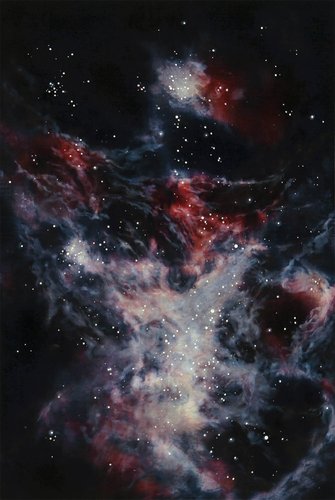
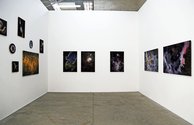

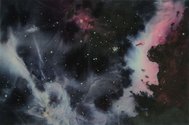
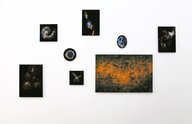

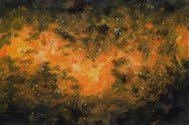
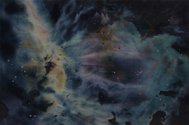




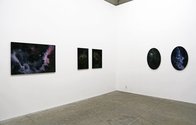

 Advertising in this column
Advertising in this column Two Rooms presents a program of residencies and projects
Two Rooms presents a program of residencies and projects



This Discussion has 0 comments.
Comment
Participate
Register to Participate.
Sign in
Sign in to an existing account.